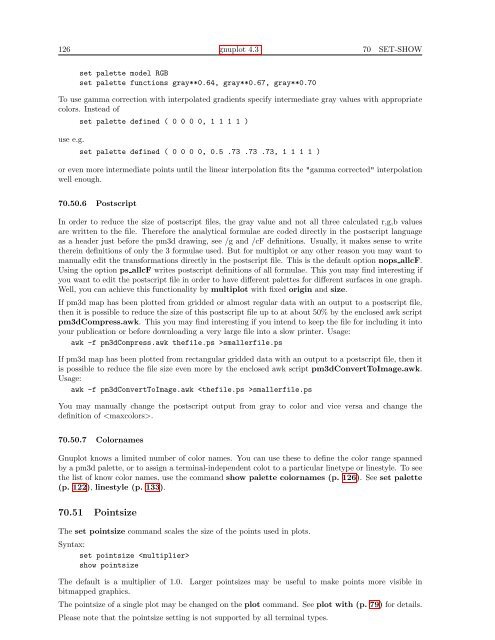gnuplot documentation
gnuplot documentation
gnuplot documentation
Create successful ePaper yourself
Turn your PDF publications into a flip-book with our unique Google optimized e-Paper software.
126 <strong>gnuplot</strong> 4.3 70 SET-SHOW<br />
set palette model RGB<br />
set palette functions gray**0.64, gray**0.67, gray**0.70<br />
To use gamma correction with interpolated gradients specify intermediate gray values with appropriate<br />
colors. Instead of<br />
use e.g.<br />
set palette defined ( 0 0 0 0, 1 1 1 1 )<br />
set palette defined ( 0 0 0 0, 0.5 .73 .73 .73, 1 1 1 1 )<br />
or even more intermediate points until the linear interpolation fits the "gamma corrected" interpolation<br />
well enough.<br />
70.50.6 Postscript<br />
In order to reduce the size of postscript files, the gray value and not all three calculated r,g,b values<br />
are written to the file. Therefore the analytical formulae are coded directly in the postscript language<br />
as a header just before the pm3d drawing, see /g and /cF definitions. Usually, it makes sense to write<br />
therein definitions of only the 3 formulae used. But for multiplot or any other reason you may want to<br />
manually edit the transformations directly in the postscript file. This is the default option nops allcF.<br />
Using the option ps allcF writes postscript definitions of all formulae. This you may find interesting if<br />
you want to edit the postscript file in order to have different palettes for different surfaces in one graph.<br />
Well, you can achieve this functionality by multiplot with fixed origin and size.<br />
If pm3d map has been plotted from gridded or almost regular data with an output to a postscript file,<br />
then it is possible to reduce the size of this postscript file up to at about 50% by the enclosed awk script<br />
pm3dCompress.awk. This you may find interesting if you intend to keep the file for including it into<br />
your publication or before downloading a very large file into a slow printer. Usage:<br />
awk -f pm3dCompress.awk thefile.ps >smallerfile.ps<br />
If pm3d map has been plotted from rectangular gridded data with an output to a postscript file, then it<br />
is possible to reduce the file size even more by the enclosed awk script pm3dConvertToImage.awk.<br />
Usage:<br />
awk -f pm3dConvertToImage.awk smallerfile.ps<br />
You may manually change the postscript output from gray to color and vice versa and change the<br />
definition of .<br />
70.50.7 Colornames<br />
Gnuplot knows a limited number of color names. You can use these to define the color range spanned<br />
by a pm3d palette, or to assign a terminal-independent colot to a particular linetype or linestyle. To see<br />
the list of know color names, use the command show palette colornames (p. 126). See set palette<br />
(p. 122), linestyle (p. 133).<br />
70.51 Pointsize<br />
The set pointsize command scales the size of the points used in plots.<br />
Syntax:<br />
set pointsize <br />
show pointsize<br />
The default is a multiplier of 1.0.<br />
bitmapped graphics.<br />
Larger pointsizes may be useful to make points more visible in<br />
The pointsize of a single plot may be changed on the plot command. See plot with (p. 79) for details.<br />
Please note that the pointsize setting is not supported by all terminal types.

















